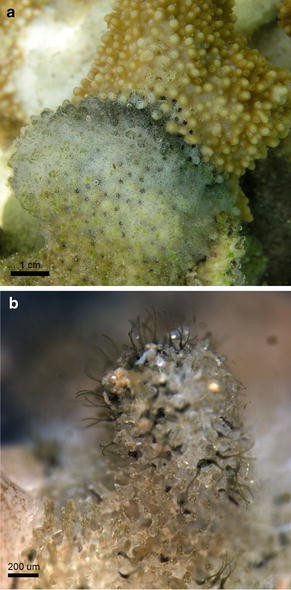Avoid common mistakes on your manuscript.
Skeletal eroding band (SEB) (Antonius 1999) is a ciliate infection associated with tissue loss in corals (Antonius and Lipscomb 2000). Here, we report the presence of this infection in Hawaii for the first time. This extends the known distribution of SEB (Antonius and Lipscomb 2000; Page and Willis 2008) and supports speculation that SEB affects corals globally (Harvell et al. 2007). SEB was identified macroscopically from a progressing black line or band surrounding healthy coral tissue (Fig. 1a; Antonius and Lipscomb 2000). Progression was indicated by algal colonization of the exposed skeleton, which appeared speckled black due to clusters of ciliate loricae (Fig. 1a), a feature that distinguishes SEB from black band disease (Antonius and Lipscomb 2000). Microscopically, the ciliates were morphologically similar to Halofolliculina corallasia, a SEB ciliate previously described in the Indo-Pacific (Antonius and Lipscomb 2000). Ciliates had black, flask-shaped loricae, embedded perpendicular to and within the coral skeleton; two paler pericytostomial wings extended from each lorica (Fig. 1b; Antonius and Lipscomb 2000). The dark and spherical macronucleus was also discernable (Fig 1b; Antonius and Lipscomb 2000). SEB was found exclusively on Montipora capitata and Pocillopora spp., consistent with previous reports of susceptibility in the coral families Acroporidae and Pocilloporidae (Page and Willis 2008). SEB prevalence was assessed using standard coral disease surveys (Harvell et al. 2007) in July 2007 and between 1.5 and 2.5 m from the reef crest on the reef slope at nine sites (N = 3 transects per site) within Kāne‘ohe Bay. The sites increased in distance from Kāne‘ohe stream mouth (0.48–4.57 km) in the southern portion of the bay, an area documented to have degraded water quality (Hunter and Evans 1995). Total SEB prevalence, including all scleractinian species, ranged from 0 to 1.1%. SEB prevalence was highest (0.92–1.1%) within 3 km of the stream mouth, at sites where mean total coral cover was 42–58% (from a range of 13.8–96.8%), and the relative contribution of Montipora capitata and Pocillopora spp. to the total coral cover was between 73 and 79%.
References
Antonius A (1999) Halofolliculina corallasia, a new coral-killing ciliate on Indo-Pacific reefs. Coral Reefs 18:300
Antonius A, Lipscomb D (2000) First protozoan coral-killer identified in the Indo-Pacific. Atoll Res Bull 481:1–21
Harvell CD, Jordan E, Merkel S, Raymundo L, Rosenberg E, Smith G, Weil E, Willis BL (2007) Coral disease: environmental change and the balance between coral and microbes. Oceanography 20:58–81
Hunter CL, Evans CW (1995) Coral-reefs in Kaneohe Bay, Hawaii—2 centuries of western influence and 2 decades of data. Bull Mar Sci 57:501–515
Page CA, Willis BL (2008) Epidemiology of skeletal eroding band on the Great Barrier Reef and the role of injury in the initiation of this widespread coral disease. Coral Reefs 27:257–272
Acknowledgments
The authors thank D Reineman, CS McKeon and NG Traylor-Knowles for field assistance. Figure 1a photo credit to CSM and funding was provided by the Edwin Pauley Foundation and a Natural Environmental Research Council (NERC) UK grant to JC Bythell. This is HIMB contribution #3333.
Author information
Authors and Affiliations
Corresponding author
Rights and permissions
About this article
Cite this article
Palmer, C.V., Gates, R.D. Skeletal eroding band in Hawaiian corals. Coral Reefs 29, 469 (2010). https://doi.org/10.1007/s00338-010-0597-2
Received:
Accepted:
Published:
Issue Date:
DOI: https://doi.org/10.1007/s00338-010-0597-2

